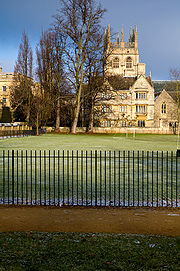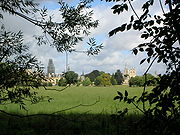
Christ Church Meadow, Oxford
Encyclopedia
Christ Church Meadow is a famous flood-meadow
, and popular walking and picnic spot in Oxford
, England
.
 Roughly triangular in shape it is bounded by the River Thames
Roughly triangular in shape it is bounded by the River Thames
(the stretch through Oxford being known as the Isis
), the River Cherwell
, and Christ Church
. It provides access to many of the college boat houses which are on an island at the confluence of the two rivers. The lower sections of the meadow, close to the Thames, are grazed by cattle, while the upper sections have sports fields.


Christ Church Meadow is owned by Christ Church
, and is thus the private property of the college, however access is allowed during the day. Access starts very early to allow rowers to go to the boathouse
s. Eights Week
and Torpids
, Oxford University's two main rowing events, and Christ Church Regatta
are held on the Thames here. In past times, ornamental wooden barge
s were moored on the river here to store boats and house spectators. However these have all now been replaced by boathouses.
James Sadler
made the first ascent in a balloon by an Englishman
from the Meadow on 4 October 1784. The balloon rose to a height of around 3,600 feet and landed six miles away near the village of Wood Eaton
near Islip
to the north-east of Oxford. A plaque notes the event. The Meadow was also the location where the medieval royal pretender, John Deydras
, claimed to have been persuaded by the devil to impersonate Edward II
in 1318.
Postwar development planned for central Oxford included a relief road
passing through the meadow and joining the district of St Ebbe's. The proposal was defeated after vigorous opposition.
Flood-meadow
A flood-meadow is an area of grassland or pasture beside a river, subject to seasonal flooding. Flood-meadows are distinct from water-meadows in that the latter are artificially created and maintained, with flooding controlled on a seasonal and even daily basis.- Examples :* Angel & Greyhound...
, and popular walking and picnic spot in Oxford
Oxford
The city of Oxford is the county town of Oxfordshire, England. The city, made prominent by its medieval university, has a population of just under 165,000, with 153,900 living within the district boundary. It lies about 50 miles north-west of London. The rivers Cherwell and Thames run through...
, England
England
England is a country that is part of the United Kingdom. It shares land borders with Scotland to the north and Wales to the west; the Irish Sea is to the north west, the Celtic Sea to the south west, with the North Sea to the east and the English Channel to the south separating it from continental...
.

River Thames
The River Thames flows through southern England. It is the longest river entirely in England and the second longest in the United Kingdom. While it is best known because its lower reaches flow through central London, the river flows alongside several other towns and cities, including Oxford,...
(the stretch through Oxford being known as the Isis
The Isis
The Isis is the name given to the part of the River Thames above Iffley Lock which flows through the city of Oxford. The name is especially used in the context of rowing at the University of Oxford...
), the River Cherwell
River Cherwell
The River Cherwell is a river which flows through the Midlands of England. It is a major tributary of the River Thames.The general course of the River Cherwell is north to south and the 'straight-line' distance from its source to the Thames is about...
, and Christ Church
Christ Church, Oxford
Christ Church or house of Christ, and thus sometimes known as The House), is one of the largest constituent colleges of the University of Oxford in England...
. It provides access to many of the college boat houses which are on an island at the confluence of the two rivers. The lower sections of the meadow, close to the Thames, are grazed by cattle, while the upper sections have sports fields.


Christ Church Meadow is owned by Christ Church
Christ Church, Oxford
Christ Church or house of Christ, and thus sometimes known as The House), is one of the largest constituent colleges of the University of Oxford in England...
, and is thus the private property of the college, however access is allowed during the day. Access starts very early to allow rowers to go to the boathouse
Boathouse
A boathouse is a building especially designed for the storage of boats, normally smaller craft for sports or leisure use. These are typically located on open water, such as on a river. Often the boats stored are rowing boats...
s. Eights Week
Eights Week
Eights Week, also known as Summer Eights, is a four-day regatta of bumps races which constitutes the University of Oxford's main intercollegiate rowing event of the year. The regatta takes place in May of each year, from the Wednesday to the Saturday of the fifth week of Trinity term...
and Torpids
Torpids
Torpids is one of two series of bumping races held yearly at Oxford University, the other being Eights. Over 130 men's and women's crews race for their colleges in six men's divisions and five women's; almost 1200 participants in total...
, Oxford University's two main rowing events, and Christ Church Regatta
Christ Church Regatta
Christ Church Regatta is a boat race in the University of Oxford which is held annually during seventh week of Michaelmas term, in which novice crews representing each college, compete against each other...
are held on the Thames here. In past times, ornamental wooden barge
Barge
A barge is a flat-bottomed boat, built mainly for river and canal transport of heavy goods. Some barges are not self-propelled and need to be towed by tugboats or pushed by towboats...
s were moored on the river here to store boats and house spectators. However these have all now been replaced by boathouses.
James Sadler
James Sadler (balloonist)
James Sadler was the first English balloonist.Sadler was the second person to make a balloon ascent in England, very soon after the Tuscan Vincent Lunardi's flight on 15 September 1784 in the grounds of the Honourable Artillery Company at Moorfields. Sadler made his ascent during the month after...
made the first ascent in a balloon by an Englishman
Englishman
Englishman may refer to:*English people*Grey Partridge*Jason Englishman, Canadian rock music singer and guitarist*Jenny-Bea Englishman, real name of the Canadien singer Esthero*Erald Briscoe, reggae musician who records under the name Englishman...
from the Meadow on 4 October 1784. The balloon rose to a height of around 3,600 feet and landed six miles away near the village of Wood Eaton
Woodeaton
Woodeaton or Wood Eaton is a village and civil parish about northeast of Oxford.-Archaeology:There was a Romano-Celtic temple north of where the parish church now stands, and probably a Romano-British settlement and shrine as well. The shrine was used successively by Roman pagans and Christians...
near Islip
Islip, Oxfordshire
Islip is a village and civil parish on the River Ray, just above its confluence with the River Cherwell in Oxfordshire, England. It is about east of Kidlington and about north of Oxford. This village in Oxfordshire is not related to Islip, New York...
to the north-east of Oxford. A plaque notes the event. The Meadow was also the location where the medieval royal pretender, John Deydras
John Deydras
John Deydras, also John of Powderham, was a pretender to the English throne during the reign of Edward II. He was executed in 1318 by hanging and his body burnt.-Background:...
, claimed to have been persuaded by the devil to impersonate Edward II
Edward II of England
Edward II , called Edward of Caernarfon, was King of England from 1307 until he was deposed by his wife Isabella in January 1327. He was the sixth Plantagenet king, in a line that began with the reign of Henry II...
in 1318.
Postwar development planned for central Oxford included a relief road
Bypass (road)
A bypass is a road or highway that avoids or "bypasses" a built-up area, town, or village, to let through traffic flow without interference from local traffic, to reduce congestion in the built-up area, and to improve road safety....
passing through the meadow and joining the district of St Ebbe's. The proposal was defeated after vigorous opposition.
External links
- Photographs: Oxford, 2004 by Richard Fuller

